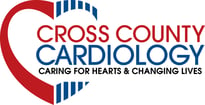This article is brought to you by the Cross County Cardiology Education Team, where we strive to empower patients with knowledge about their heart health. Today, we’re exploring aortic stenosis and the transformative potential of Transcatheter Aortic Valve Replacement (TAVR). Understanding these advancements can help you take control of your health and live a fuller life.
Aortic Stenosis: What You Need to Know
Aortic stenosis (AS) is a condition in which the aortic valve, responsible for regulating blood flow from the heart to the body, becomes narrowed and stiff. This restricts blood flow and forces the heart to work harder, leading to symptoms like fatigue, chest pain, and shortness of breath. Left untreated, severe aortic stenosis can lead to heart failure and carries a high mortality rate.
Over 1.5 million people in the U.S. are affected, with 500,000 experiencing severe symptoms (AHA). More than 50% of untreated severe cases lead to death within two years of symptom onset (Cleveland Clinic). Many patients mistake early symptoms for normal aging, leading to delayed diagnoses and higher risks.
What Causes Aortic Stenosis?
While aging is a primary factor, other contributors include:
- Calcium buildup: Age-related deposits narrow the valve.
- Chronic conditions: High blood pressure, diabetes, and kidney disease exacerbate stiffness.
- Lifestyle factors: Smoking and high cholesterol increase stress on the heart.
- Congenital defects: Conditions like bicuspid aortic valve predispose some individuals to early stenosis.
Introducing TAVR: A Game-Changing Treatment
For decades, open-heart surgery was the standard treatment for severe aortic stenosis. Now, TAVR offers a minimally invasive alternative that has revolutionized care. Initially reserved for high-risk patients, TAVR is now an option for individuals across all risk levels.
TAVR involves threading a catheter through an artery, typically in the groin, to deliver and position a new valve within the old one. This procedure eliminates the need for open-heart surgery, reducing risks and significantly shortening recovery times.
Key Benefits of TAVR:
- Short recovery: Most patients resume activities within days.
- Minimally invasive: No chest incisions or extensive downtime.
- Improved outcomes: Studies show reduced symptoms and increased life expectancy (JACC).
- Expanded access: Approved for patients at all risk levels, ensuring more individuals benefit.
Why Choose Cross County Cardiology for TAVR?
At Cross County Cardiology, we specialize in diagnosing and treating aortic stenosis using the most advanced tools available. Our dedicated team ensures every patient receives a thorough evaluation and a personalized treatment plan tailored to their unique needs.
For those who qualify for TAVR, our state-of-the-art facilities enable us to perform this groundbreaking procedure with precision and care. From the initial diagnosis to treatment and recovery, our compassionate team supports you every step of the way, making your journey to better heart health as seamless as possible.
The Future of Heart Health Is Here
Aortic stenosis no longer has to define your life. Innovative treatments like TAVR offer renewed hope, shorter recovery times, and better quality of life for patients facing this serious condition.
If you or a loved one are experiencing symptoms or have been diagnosed with severe aortic stenosis, don’t wait. Reach out to explore your treatment options today. At Cross County Cardiology, we’re here to help you protect your heart—and your future.



